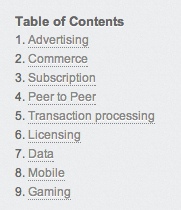MBA Mondays: Revenue Models - Gaming
Like last week's post on mobile revenue models, gaming isn't a revenue model itself, but it does offer a number of interesting revenue models and is worth discussing in a post in this series. This is the last post in the revenue model series, which is based on the peer produced revenue model hackpad we created at the start of the series.
Gaming is interesting because there are a number of revenue options that game developers can choose from when thinking about how to make money from their game. The hackpad lists the following:
There is still a sizeable business in selling a version of the game to the game player. That's how the console game (xbox, etc) market works. It is also how downloadable games market works. And there is a vibrant market in mobile games that you have to pay for to play.
But the games market has been moving to newer models in recent years. In app upgrades is certainly one of the more important revenue models. Many of the most popular mobile games are free to play but offer in app upgrades to get more game elements or simply to eliminate the ads. This is an example of the freemium business model in action.
Advertising is another important revenue model. For many web based games, advertising is the dominant form of revenue. On mobile, advertising supports the free offer and the elimination of advertising is often the value proposition for the in app upgrade.
The revenue model that is mostly (but not totally) unique to gaming is virtual goods. Virtual goods (like a tractor in Farmville) allow the player to have more capability in the game and they can be earned over time but are often purchased to enhance game play. This revenue model was inititally created in the asian gaming market but has been adopted by game developers all over the world.
I have been waiting for non gaming web and mobile services to adopt the virtual goods model but have yet to see anything that feels like it is working really well. Virtual goods is another excellent implementation of the freemium approach to business model.
There are game developers who use all of these models at the same time. They might sell their game on certain platforms, they might offer a free ad supported version on mobile with in app upgrades and virtual goods. In many ways, I think the gaming market is the most sophisticated about revenue models of all the sectors in web and mobile. That may stem from the fact that most games have a finite life and so the developer has to extract real revenue quickly to get a return on the investment they have made in developing the game. I think there is a lot that the rest of the web and mobile services world can learn from the gaming market.





